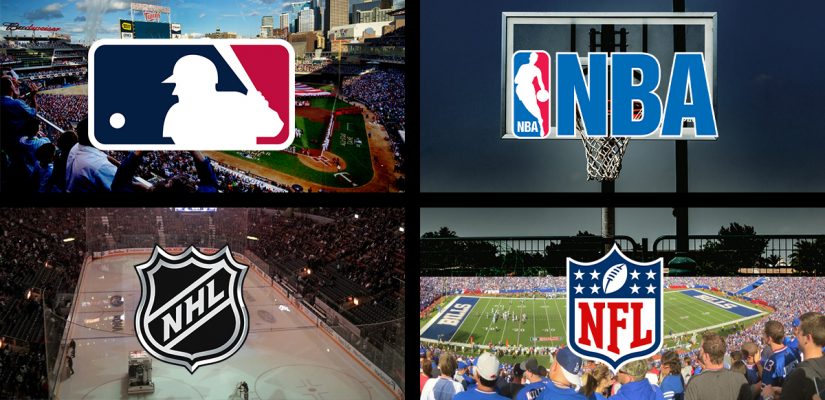
Sports are a constantly growing business. In 2022, the sports industry reached a revenue of $501.43 billion, and that number is expected to grow to $707.84 billion by 2026[1]. With this growing industry, many leagues are expanding and adding more teams, so how exactly do they do that? In this blog post, I am going to analyze the four major sports leagues in the United States, how they expand, which expansion system is best at setting a team up to succeed, and which system works best from a fan’s perspective. All leagues use an expansion draft in some way, shape, or form. An expansion draft is a selection process where the new team can pick players from existing teams to be moved to theirs. Each league will be evaluated on it’s expansion draft, other specific rules and regulations, and the success of the expansion teams since their creation.
To give some background before diving into each league, let’s first clarify what the four major sports are in the US. The National Football League (NFL) is the most profitable sports league in the world with an estimated $16 billion in yearly revenue as of 2020[2]. Coming in second place is Major League Baseball (MLB), with a revenue of $10.7 billion, and the National Basketball Association (NBA) takes third place with $8.8 billion in annual revenue. Soccer then rounds out the top five, with the English Premier League and La Liga taking fourth and fifth places respectfully. The National Hockey League (NHL) comes in sixth place, bringing in an estimated $5.09 billion annually. With all of that money coming in, each league has decided to expand its total number of teams in recent years, the latest being the NHL in 2021. So, let’s dive into how each league went about adding new franchises, and which systems have worked best.
Going in order of most profitable, the NFL is the first to look at. The latest expansion for the NFL was in 2002 when the Houston Texans were added to the AFC South. This new franchise brought the total league-wide team count to 32, which evened out the AFC and NFC Conferences. This is a common theme that the other American sports leagues also practice since it’s harder to build a playoff picture with uneven conferences. How they execute the draft and what other supplemental regulations go along with it differs from league to league. For example, along with the expansion draft, the NFL granted the Houston Texans the first overall pick in the 2002 NFL Draft, which was unique to their league’s expansion. In the expansion draft, the Texans had 155 available players to choose from. Each existing team was able to protect five players that couldn’t be picked, and Houston could either pick 30 players or reach $27.2 million in contracts to stop the event. Houston ended up taking 19 players in a draft that is looked back on as a curse to the franchise. Their first overall pick, Tony Boselli, was a five-time pro bowl left tackle who the Texans thought would anchor their offensive line and be a cornerstone for their team as a whole. Unfortunately, because of a shoulder injury he sustained while playing in Jacksonville, Boselli wouldn’t play a single game for Houston. Since then, the Texans are said to be under the “Boselli Curse”[3] and haven’t found any success whatsoever since their creation. Their overall record comes out to a sad 142 wins, 195 losses, and one tie. In their 20 seasons, they have a four-win, six-loss playoff record, and have never made it past the first round.
The next league to analyze is the MLB. This expansion draft which occurred in 1997 was unique since it had two teams participating and taking turns over the course of three rounds. The MLB is the only league out of the four that expanded and added two teams at the same time. This expansion added the Arizona Diamondbacks, along with the Tampa Bay Devil Rays. Throughout the three rounds, both teams selected 35 players from the 28 existing squads. Each of the existing teams were allowed to protect 15 of their players in round one, then three more each round after that. Also, the Diamondbacks and Devil Rays were only allowed to pick players from a team once per round. To decide who went first, the teams flipped a coin. The winner could decide whether they wanted to have the first pick or take the second and third overall picks. Choosing to go second also allowed that team to pick first in the other two rounds[4,5]. The Diamondbacks ended up winning the toss, and they chose to pick second. Unlike the Houston Texans, these teams aren’t remembered for their poor picks in their expansion draft. The teams have nearly identical records throughout their 26 seasons, with the Diamondbacks going 1,926-2,045 and the Devil Rays (now just the Rays) going 1,931-2,037. Arizona first made the playoffs in 1999 and went on to win the World Series in 2001. Tampa Bay had a slower start, making the playoffs for the first time in 2008 where they would go on to lose the World Series against Philadelphia, but right now they are the best team in baseball with a 19-3 record.
Next is the NBA, whose latest expansion was in 2004 when the Charlotte Bobcats (now Hornets) were added to the league. This was another expansion draft where the newly added team was able to pick veterans from teams around the league. This time, the existing teams were able to protect eight players while Charlotte could pick anywhere between 14 and 29 players. There was also no salary cap enforced in this draft, so Charlotte could spend as much or as little as they would like while also going after free agents in the offseason. The Bobcats ended up stealing 19 players away from other teams, but there was another catch with their expansion: The NBA gave Charlotte the fourth overall pick in the 2004 NBA Draft. Instead of receiving the first pick like the Houston Texans, the Bobcats were given the fourth pick because “the other 29 NBA team owners didn’t want Charlotte to show up and immediately land a top three draft pick”[6]. However, what is similar to the Houston Texans is how miserably bad Charlotte has been since they were created. In their 19-year existence, Charlotte has won 611 games and lost 904, while making the playoffs just three times and never winning a single playoff series.
Lastly, the NHL’s expansion in 2021 needs to be discussed. Two years ago, the Seattle Kraken became the 32nd team in the league, evening out the conferences that had become odd due to the previous expansion in 2017. In this expansion draft, the Kraken were required to pick 30 players, one from each team. The only team exempt was the Las Vegas Golden Knights, who were the previous newest team from that 2017 expansion draft. The Golden Knights, however, did not receive a share of the $650 million expansion fee that the owners of the Kraken paid to the league when they entered it. Out of those 30 payers selected, Seattle was forced to pick a total of 14 forwards, nine defensemen, and three goalies. The other four picks could be designated to whichever position the team desired. Adding to this, the Kraken were required to take a minimum of 20 players that were under contract for the 2021-2022 season, with their salaries totaling between 60% to 100% of the league-wide salary cap. As for how many players the existing franchises could protect, each team could reserve eight skaters and a goalie or seven forwards, three defensemen, and a goalie. According to an article written by nhl.com, “these rules [were] in place to ensure the Kraken [were] picking from a player pool with potential to construct a competitive roster and other rules to protect the 30 teams losing top performers”[7]. These rules seem to have worked, as the Kraken are competing in the Stanley Cup Playoffs in just their second season. In the two seasons since their creation, the Kraken have a combined record of 72 wins, 75 losses, and 14 losses in overtime. The reason why overtime losses are counted is because there are no ties, and those losses in extra time grant the team one point. This means that the Kraken have racked up 158 points, an average of 79 per season, in their first two years. Something important to note about the NHL’s style of expansion is the success of the Golden Knights since they expanded in 2017. Since then, they have won 267 games, lost 147, and lost 41 in overtime. Even if their overtime losses were added to their regulation losses, Vegas would be the only expansion team in any American sports league since the start of the 21stcentury to have a winning record. Also, in their inaugural season, they went to the Stanley Cup Finals and have been in the playoffs in four out of their first six seasons, with a playoff record of 40 wins and 29 losses.
Now it’s time to compare and review the expansion processes for each of the four leagues. Out of all four expansions, only two teams were granted high draft picks to go alongside their draft, those teams being the Houston Texans of the NFL and the Charlotte Bobcats of the NBA. It can be said that those picks didn’t offer much help as the Texans and Bobcats have the worst winning percentage out of any of the five teams. Something that could’ve also played a role in their poor winning percentages is the number of players that those teams selected. For the MLB and NHL, the Arizona Diamondbacks, Tampa Bay Devil Rays, and the Seattle Kraken all had a set number of players that they had to choose. This was not the case for both the NFL and NBA, where they had to hit a threshold of players or salary cap collected. It’s likely that the volume of players selected in the MLB and NHL gave the teams more of an advantage because they were able to build better squads by eliminating the fat from the roster post-draft. Now that some of the reasons that make different formats for expansion more successful than others have been realized, it’s time to try and answer the question of which format works best from a fan’s perspective.
Which system works better from a fan’s perspective is a completely different, and likely objective story. Fans of teams would prefer the expansion formats that the NFL and NBA use. This is because the new teams being added to the league take a while to find success, so fans of other teams don’t feel as if their squad got cut in line on the way into the playoffs. Fans of leagues, however, would prefer similar expansion formats to those that the MLB and NHL use because immediate competition gets added to their league. This being said, fans don’t come in two types. There is more of a spectrum of fandom that people fall into, and the type of expansion that they prefer completely depends on their independent tastes. In conclusion, the system that does the best job at creating a competitive team is the NHL, but as for fans, which system works best is based completely off of preferences and differs from person to person.
Thank you for the read! Please let me know what you think of this longer format in the comments below, I’d love to hear your opinions!
References:
[1] – https://www.statista.com/statistics/370560/worldwide-sports-market-revenue/
[2] – https://blog.bizvibe.com/blog/largest-sports-leagues-by-revenue
[4] – https://www.mlb.com/news/mlb-expansion-draft-history
[5] – https://seamheads.com/blog/2008/07/04/starting-fresh-the-expansion-of-1998/
[6]- https://www.sbnation.com/nba/2017/8/9/16117208/bobcats-suns-steve-nash-2004-nba-expansion-draft
[7] – https://www.nhl.com/kraken/news/expansion-draft-process-explained/c-325573792
PS: More Bruins and Celtics content soon to come….
